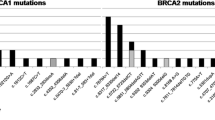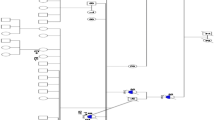Abstract
Introduction
Breast cancer is the most frequent female malignancy worldwide. Among them, some cases have hereditary susceptibility in two leading genes, BRCA1 and BRCA2. Heterozygous germ line mutations in them are related with increased risk of breast, ovarian and other cancer, following autosomal dominant inheritance mode.
Methods and Results
For purpose of early finding, early diagnosis and early treatment, mutation detecting of BRCA1/2 genes was performed in unselected 300 breast or ovarian patients and unaffected women using next-generation sequencing and then confirmed by Sanger sequencing. A non-previously reported heterozygous mutation c.8946_8947delAG (p.D2983FfsX34) of BRCA2 gene was identified in an unaffected Chinese woman with family history of breast cancer (her breast cancer mother, also carrying this mutation). The BRCA2-truncated protein resulted from the frame shift mutation was found to lose two putative nuclear localization signals and a Rad51-binding motif in the extreme C-terminal region by bioinformatic prediction. And then in vitro experiments showed that nearly all the mutant protein was unable to translocate to the nucleus to perform DNA repair activity. This novel mutant BRCA2 protein is dysfunction.
Conclusions
We classify the mutation into disease causing and conclude that it is the risk factor for breast cancer in this family. So, conducting the same mutation test and providing genetic counseling for this family is practically meaningful and significant. Meanwhile, the identification of this new mutation enriches the Breast Cancer Information Core database, especially in China.




Similar content being viewed by others
References
Collaborative Group on Hormonal Factors in Breast, Cancer (2001) Familial breast cancer: collaborative reanalysis of individual data from 52 epidemiological studies including 58,209 women with breast cancer and 101,986 women without the disease. Lancet 358(9291):1389–1399
D’Argenio V et al (2015) The molecular analysis of BRCA1 and BRCA2: next-generation sequencing supersedes conventional approaches. Clin Chim Acta 446:221–225
Davies OR, Pellegrini L (2007) Interaction with the BRCA2 C terminus protects RAD51-DNA filaments from disassembly by BRC repeats. Nat Struct Mol Biol 14(6):475–483
Erturk E et al (2015) BRCA mutations cause reduction in miR-200c expression in triple negative breast cancer. Gene 556(2):163–169
Esashi F et al (2007) Stabilization of RAD51 nucleoprotein filaments by the C-terminal region of BRCA2. Nat Struct Mol Biol 14(6):468–474
Fan L et al (2014) Breast cancer in China. Lancet Oncol 15(7):e279–e289
Gerhardus A et al (2007) Diagnostic accuracy of methods for the detection of BRCA1 and BRCA2 mutations: a systematic review. Eur J Hum Genet 15(6):619–627
Hall JM et al (1990) Linkage of early-onset familial breast cancer to chromosome 17q21. Science 250(4988):1684–1689
Hallam S et al (2015) BRCA1/2 mutation-associated breast cancer, wide local excision and radiotherapy or unilateral mastectomy: a systematic review. Clin Oncol (R Coll Radiol) 27(9):527–535
Harmsen MG et al (2015) How medical choices influence quality of life of women carrying a BRCA mutation. Crit Rev Oncol Hematol 96(3):555–568
Laraqui A et al (2015) BRCA genetic screening in middle Eastern and North African: mutational spectrum and founder BRCA1 mutation (c.798_799delTT) in North African. Dis Markers 2015:194293
Larsen MJ et al (2014) Hereditary breast cancer: clinical, pathological and molecular characteristics. Breast Cancer (Auckl) 8:145–155
Lichtenstein P et al (2000) Environmental and heritable factors in the causation of cancer–analyses of cohorts of twins from Sweden, Denmark, and Finland. N Engl J Med 343(2):78–85
Lim MJ et al (2010) An ELISA-based high throughput protein truncation test for inherited breast cancer. Breast Cancer Res 12(5):R78
Mehrgou A, Akouchekian M (2016) The importance of BRCA1 and BRCA2 genes mutations in breast cancer development. Med J Islam Repub Iran 30:369
Miki Y et al (1994) A strong candidate for the breast and ovarian cancer susceptibility gene BRCA1. Science 266(5182):66–71
Moynahan ME, Pierce AJ, Jasin M (2001) BRCA2 is required for homology-directed repair of chromosomal breaks. Mol Cell 7(2):263–272
Ng PC, Henikoff S (2003) SIFT: predicting amino acid changes that affect protein function. Nucl Acids Res 31(13):3812–3814
Patel KJ et al (1998) Involvement of Brca2 in DNA repair. Mol Cell 1(3):347–357
Pisano M et al (2011) A new mutation of BRCA2 gene in an Italian healthy woman with familial breast cancer history. Fam Cancer 10(1):65–71
Pradjatmo H (2015) Methylation status and expression of BRCA2 in epithelial ovarian cancers in Indonesia. Asian Pac J Cancer Prev 16(18):8599–8604
Prensner JR et al (2014) PCAT-1, a long noncoding RNA, regulates BRCA2 and controls homologous recombination in cancer. Cancer Res 74(6):1651–1660
Roy R, Chun J, Powell SN (2012) BRCA1 and BRCA2: different roles in a common pathway of genome protection. Nat Rev Cancer 12(1):68–78
Scalia-Wilbur J et al (2016) Breast cancer risk assessment: moving beyond BRCA 1 and 2. Semin Radiat Oncol 26(1):3–8
Schlacher K et al (2011) Double-strand break repair-independent role for BRCA2 in blocking stalled replication fork degradation by MRE11. Cell 145(4):529–542
Schwarz JM et al (2010) MutationTaster evaluates disease-causing potential of sequence alterations. Nat Methods 7(8):575–576
Sharan SK, Bradley A (1997) Murine Brca2: sequence, map position, and expression pattern. Genomics 40(2):234–241
Sharan SK et al (1997) Embryonic lethality and radiation hypersensitivity mediated by Rad51 in mice lacking Brca2. Nature 386(6627):804–810
Sheikh A et al (2015) The spectrum of genetic mutations in breast cancer. Asian Pac J Cancer Prev 16(6):2177–2185
Spain BH et al (1999) Truncated BRCA2 is cytoplasmic: implications for cancer-linked mutations. Proc Natl Acad Sci USA 96(24):13920–13925
Tavtigian SV et al (1996) The complete BRCA2 gene and mutations in chromosome 13q-linked kindreds. Nat Genet 12(3):333–337
West SC (2003) Molecular views of recombination proteins and their control. Nat Rev Mol Cell Biol 4(6):435–445
Wooster R et al (1994) Localization of a breast cancer susceptibility gene, BRCA2, to chromosome 13q12-13. Science 265(5181):2088–2090
Yano K et al (2000) Nuclear localization signals of the BRCA2 protein. Biochem Biophys Res Commun 270(1):171–175
Yiannakopoulou E (2014) Etiology of familial breast cancer with undetected BRCA1 and BRCA2 mutations: clinical implications. Cell Oncol (Dordr) 37(1):1–8
Yoshikawa Y et al (2005) Insertion/deletion polymorphism in the BRCA2 nuclear localization signal. Biomed Res Tokyo 26(3):109–116
Acknowledgements
We thank all of the donors who participated in this program and all of our colleagues at Bao’an Maternal and Children Healthcare Hospital. This work was supported by grants from the National key research and development program (2016YFC1000500), Shanghai Municipal Commission of Health and Family Planning (2013ZYJB0015) and Shanghai Municipal Commission of Science and Technology (14DJ1400103).
Author information
Authors and Affiliations
Corresponding authors
Ethics declarations
Conflict of interest
The authors declare that they have no conflict of interest.
Ethical approval
All procedures performed in studies involving human participants were in accordance with the ethical standards of the institutional and/or national research committee and with the 1964 Helsinki declaration and its later amendments or comparable ethical standards. This article does not contain any studies with animals performed by any of the authors.
Informed consent
Informed consent was obtained from all individual participants included in the study.
Additional information
Duan Ma and Likuan Xiong have contributed equally to this work.
Rights and permissions
About this article
Cite this article
Ma, J., Yang, J., Jian, W. et al. A novel loss-of-function heterozygous BRCA2 c.8946_8947delAG mutation found in a Chinese woman with family history of breast cancer. J Cancer Res Clin Oncol 143, 631–637 (2017). https://doi.org/10.1007/s00432-016-2327-9
Received:
Accepted:
Published:
Issue Date:
DOI: https://doi.org/10.1007/s00432-016-2327-9




